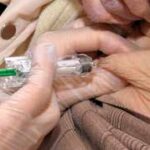As the U.S. and other patents for branded denosumab products get closer to expiring, drug manufacturers are initiating clinical trials for more affordable, biosimilar versions of the treatment.


As the U.S. and other patents for branded denosumab products get closer to expiring, drug manufacturers are initiating clinical trials for more affordable, biosimilar versions of the treatment.

Clinical trials of biosimilar treatments, including a phase 1 study of SB17, which is biosimilar to ustekinumab, and two phase 3 studies investigating of SB16, which is biosimilar to denosumab, are currently recruiting.

Matthew Phelan |
NEW YORK (Reuters Health)—Long-term glucocorticoid users see greater gains in spine bone-mineral density when treated with the monoclonal antibody denosumab vs. oral alendronate, a small clinical trial shows. The drug also proved superior at lowering bone-turnover markers at 12 months, researchers in Hong Kong report in Bone.1 “Denosumab may be considered as an alternative first-line…
Marilynn Larkin |
NEW YORK (Reuters Health)—Denosumab showed biological efficacy against osteolysis after total hip replacement in a proof-of-concept trial. “Denosumab is already a well-established licensed drug for the indications of osteoporosis and metastatic bone lesions in cancer, and has been shown to be effective in reducing erosions in inflammatory arthritis,” Dr. Mark J.M. Wilkinson of the University…

ACR Convergence 2020—At two plenary sessions, speakers highlighted key findings, including results on the QTc interval in patients on hydroxychloroquine, and data from a study on denosumab vs. alendronate for glucocorticoid-induced osteoporosis. The QTc Interval & Hydroxychloroquine The safety profile and optimal dosing of hydroxychloroquine has been a topic for decades because it is known…
Megan Brooks |
NEW YORK (Reuters Health)—Denosumab injection delays of more than four months are associated with an increased risk of fracture compared with on-time injections, especially at the spine, new research indicates. “This study suggests the importance of timely denosumab administration when used for long-term osteoporosis management,” the researchers write in Annals of Internal Medicine.1 “When starting…
Marilynn Larkin |
NEW YORK (Reuters Health)—In postmenopausal women and men treated for at least two years with denosumab, a single infusion of zoledronate given after denosumab discontinuation does not completely prevent bone turnover and loss, researchers say. Given the findings, “bone mineral density (BMD) should probably be higher than the current target for discontinuation of bisphosphonate treatment…
Marilynn Larkin |
NEW YORK (Reuters Health)—The osteoporosis drug denosumab is associated with a higher incidence of serious infections compared with placebo, but the risk is similar to comparator drugs, a systematic review and meta-analysis reveals. Talia Diker-Cohen, MD, PhD, of Tel Aviv University, and colleagues searched the literature through May 2019 for randomized controlled trials of denosumab…
Anne Harding |
NEW YORK (Reuters Health)—Adding high-dose teriparatide to denosumab therapy leads to substantially greater increases in bone-mineral density (BMD) than combination therapy with low-dose teriparatide, a new phase 4 study shows. “The combination of denosumab and teriparatide, particularly with high-dose teriparatide of 40 ug daily, may be of benefit to patients at very high risk of…
Megan Brooks |
NEW YORK (Reuters Health)—Rates of osteoporotic fracture were similar three years after starting either denosumab or alendronate in a real-world Danish population-based cohort study. “Previous studies have shown that denosumab is more efficacious than alendronate in increasing bone mineral density (BMD), possibly the best proxy outcome for subsequent fracture risk. However, previous studies were underpowered…